Who Is Maarten Martens?
When Maarten Martens was promoted from assistant coach to head coach at AFAS Stadion last January, he was taking what has become one of the biggest jobs in Dutch club football over the years.
From household names in the country like Louis van Gaal, Dick Advocaat, and Ronald Koeman to prospective trainers like Arne Slot and Pascal Jansen, AZ has had an impressive list of managers come in and out of the door over the last couple of decades.
Martens had big shoes to fill, especially coming into a club that expected to finish among the top four teams in the country and be a European regular every year.
The 40-year-old Belgian, who served the club as a player 226 times between 2006 and 2014, took over in his current function in the middle of last January, managing to steer AZ to a fourth-place finish at the end of the season.
They finished four points off a Champions League berth but did fend off the challenge of Ajax, who they finished nine points above to clinch a Europa League group stage spot.
With his only prior head coaching experience coming at youth and reserve level, last season was Martens’ big breakthrough with a change to take charge of one of the biggest clubs in Holland today.
Now that his feet have gotten wet from that first half-season experience, this is his first full term in this sort of position at this level, one that he’s been taking with both hands, as results thus far have indicated.
This tactical analysis will take an in-depth look at AZ Alkmaar’s start to the Eredivisie campaign and what Martens has built the team’s success off of with three wins and four clean sheets.
Maarten Martens Tactics & Attacking Style
As has been synonymous with Dutch football for many decades, AZ is a team that likes to bring the game to the opposition and play on the front foot, although they are more direct and quick with their actions to get the ball from back to front as often as they can.
The base system of Martens’ AZ is a 4-3-3 with two pivots in Jordy Clasie and Peer Koopmeiners and a roaming attacking midfielder in Sven Mijnans.
Playing with two defensive midfielders allows AZ to establish control both on and off the ball while creating a foundation for Mijnans and the front three to build on offensively.
We’ll dissect their offensive strategy in depth below.
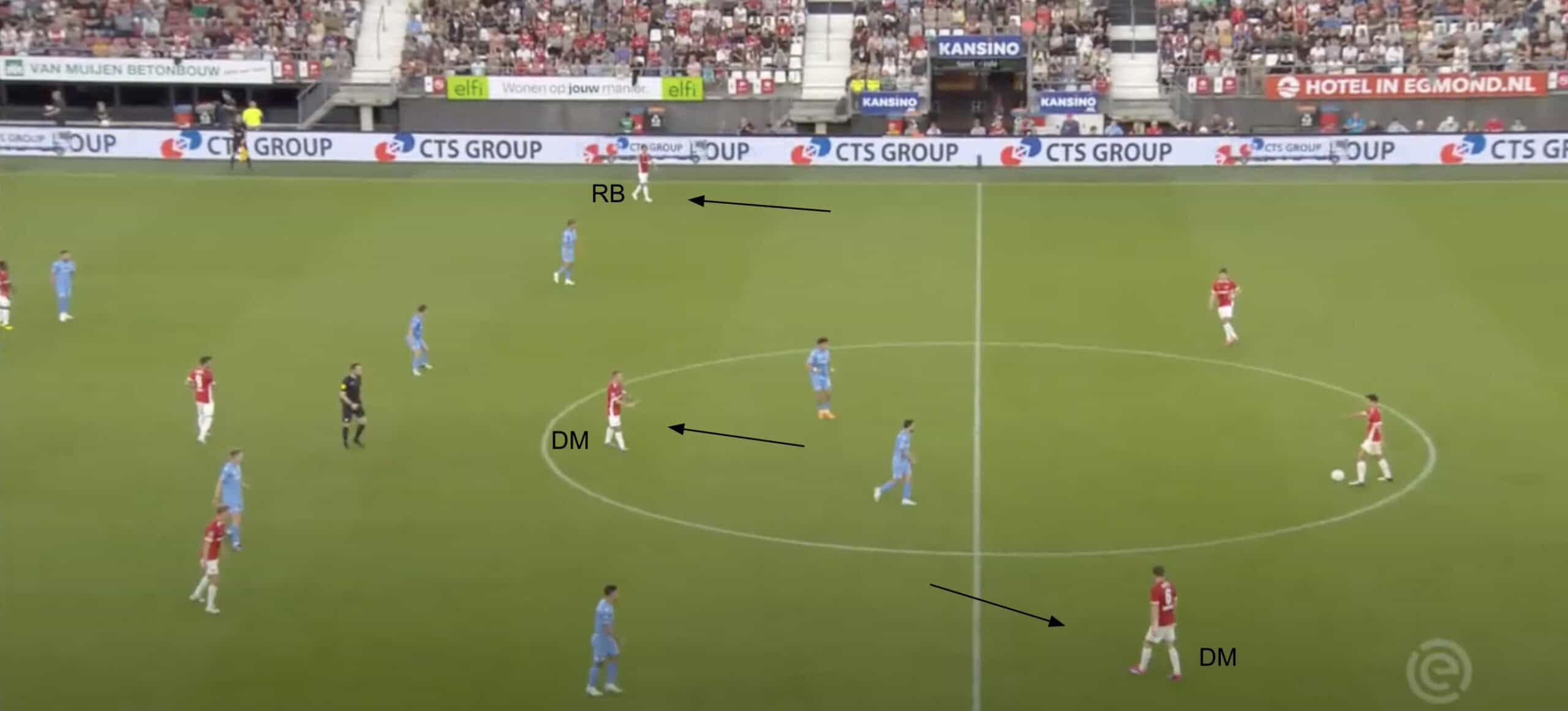
One of the key things to note about the double pivot in this AZ team is in the way they set the tempo for the way the team plays and what they offer tactically on the attacking side of the game.
An example of that could be found in the early build-up phase.
As AZ like to play out from the back, we can often find the pivots taking turns between who drops deeper into the defensive line to allow the full-backs to push up and who stays further forward as a progressive passing option in midfield.
In the above graphic, we can see Koopmeiners assuming the former role by dropping into the space usually taken up by a left-back.
This allows the full-backs Seiya Maikuma and David Møller Wolfe (not pictured) to take up an advanced position in the attack.
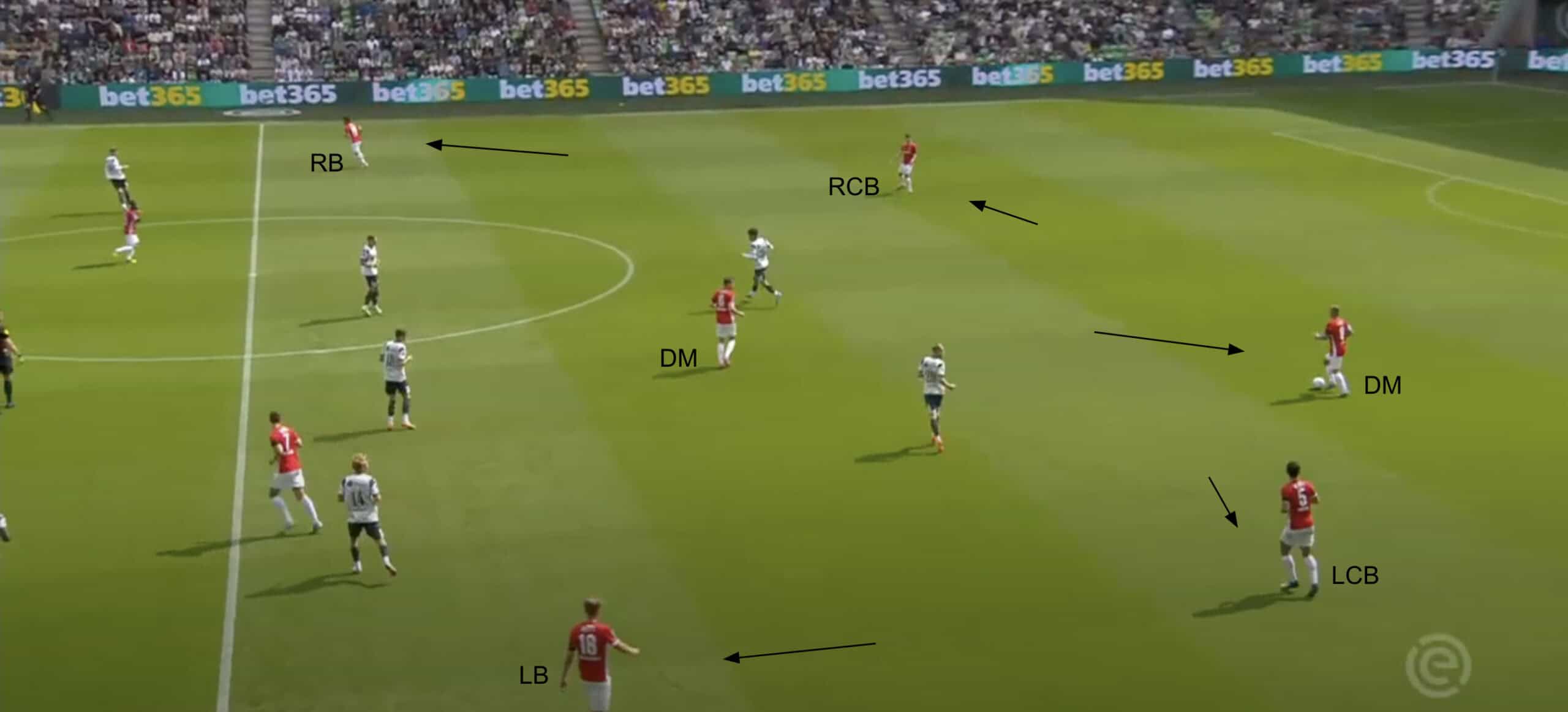
Here is another example from the game against Groningen: Clasie dropping the deeper of the two pivots between the centre-halves, who moved wider.
At the same time, Koopmeiners offered a short option in midfield.
This gives AZ flexibility in how they want to progress the ball, either via the pivot that stays in midfield, a switch to either full-back in the wide areas, or any of the back three, in this instance, could carry the ball forward on a run from deep.
The back players also receive support from underlapping runs from the forward players, with Mijnans always spotted constantly looking for pockets of space to receive the ball throughout any AZ game.
Troy Parrott, the team’s new Irish #9, and first-choice wingers Ibrahim Sadiq and Ruben van Bommel also interchange who drops deeper to offer an outlet and who stays forward for attacks.
This all allows AZ to vary in the way they progress their attacks and gives them options that they can utilise depending on the situations each game brings.
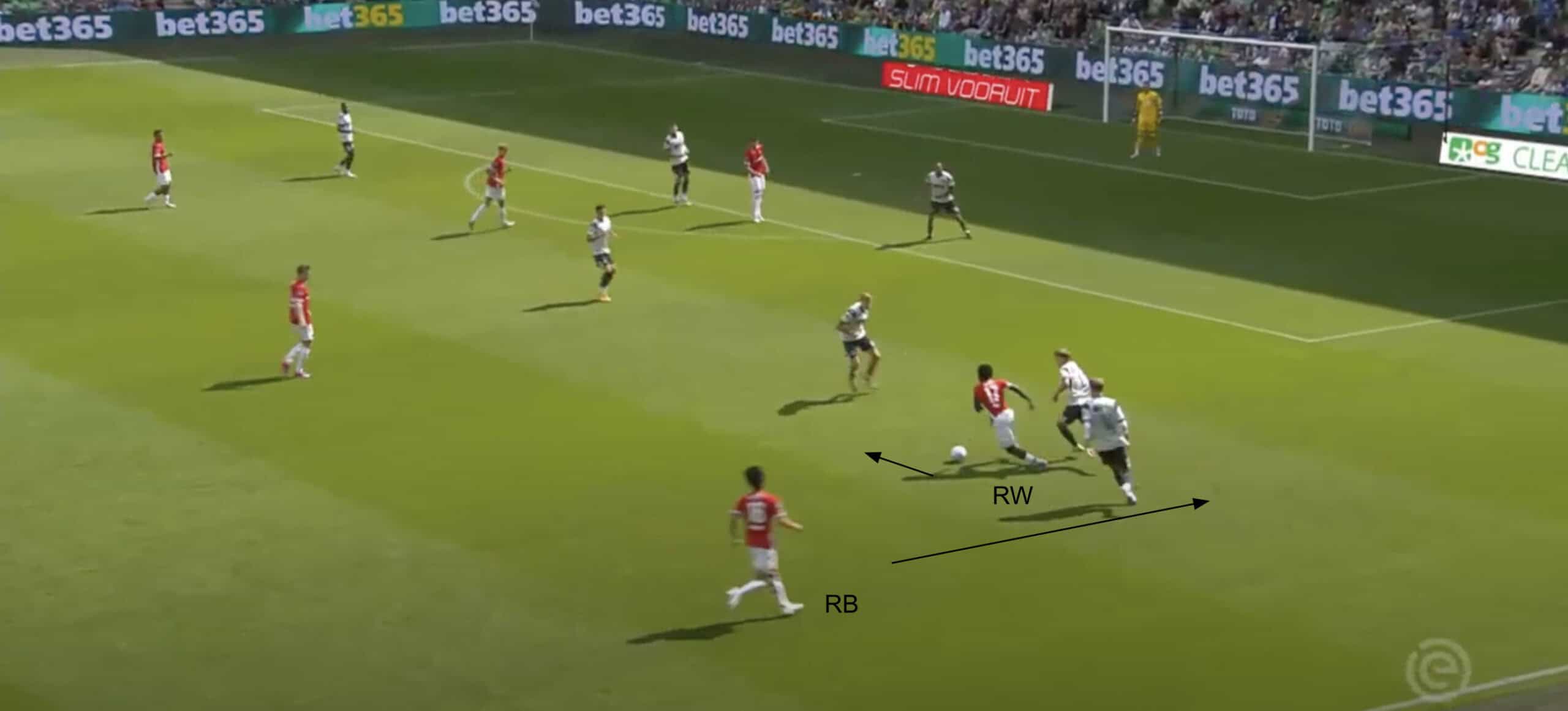
As mentioned earlier, their full-backs also play a key role in the offensive proceedings, with both always looking to move forward into spaces in attack when the opportunities arise.
In the example above, we see Jayden Addai, one of the substitutes against Groningen and a different profile from Sadiq, coming inside on the ball, allowing Maikuma to move into the space on the outside.
His run is rewarded, too, with a reverse ball back towards him.
Although the play doesn’t end in a goal, it’s a sample of the positivity in his play that offers more firepower to the attack going forward.
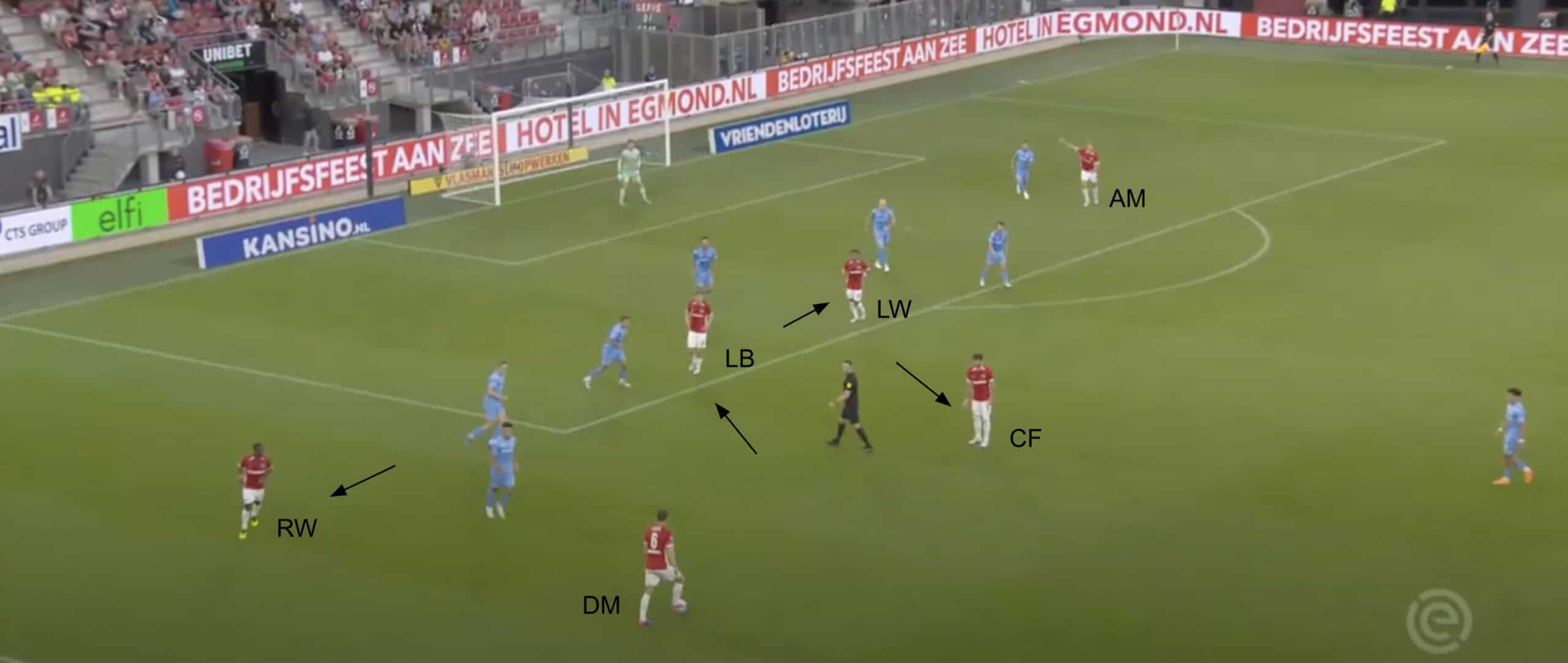
Another important element of their attack is the constantly fluctuating and interchangeable movements of their attacking players, which makes them difficult to defend against.
We already touched on how the pivots take turns between who drops and pushes up, but here above, we can see how that looks on the other end of the field.
Sadiq and Myron van Brederode (the left winger above, who has since been loaned out to Fortuna Düsseldorf) are seen switching sides from their starting positions.
At the same time, Parrott and Mijnans similarly take turns determining who takes up higher positions and who comes closer to the ball to receive.
Again, this allows AZ to vary their attacks, as each player pictured above has a different profile and skillset that they offer to the offence.
This gives Martens’ side options to change up their approach when needed and keeps things fresh and unpredictable for the opposition.
AZ Alkmaar Ball Progression Map
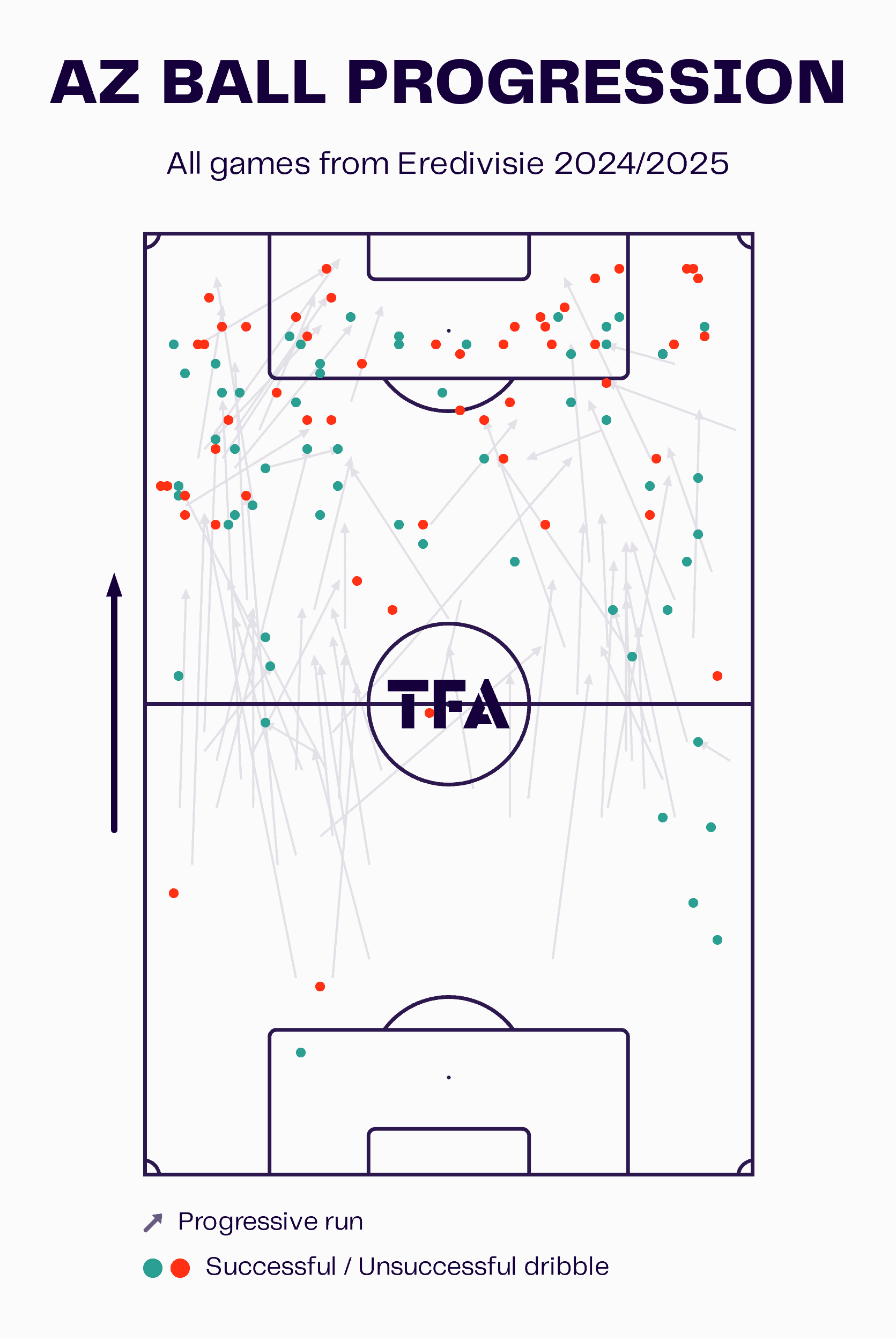
The data visualisation shared above shows that AZ’s attacks see a lot of activity, particularly in the advanced wide areas.
This is supported by the evidence of the role their full-backs play on that end of the pitch in supporting the usual front four there.
They’ve been able to mix it well between playing directly and vertically, and although they aren’t converting their chances regularly yet, the signs are encouraging that they will soon.
AZ Alkmaar Defending Style
While their offensive prospects are very interesting, given how they approach that side of the game, what’s really caught the eye this season is their defensive solidity under Martens.
They have yet to allow a goal.
They are the only team in the league with four consecutive shutouts this term, and below, we’ll explore some of the keys to their success.
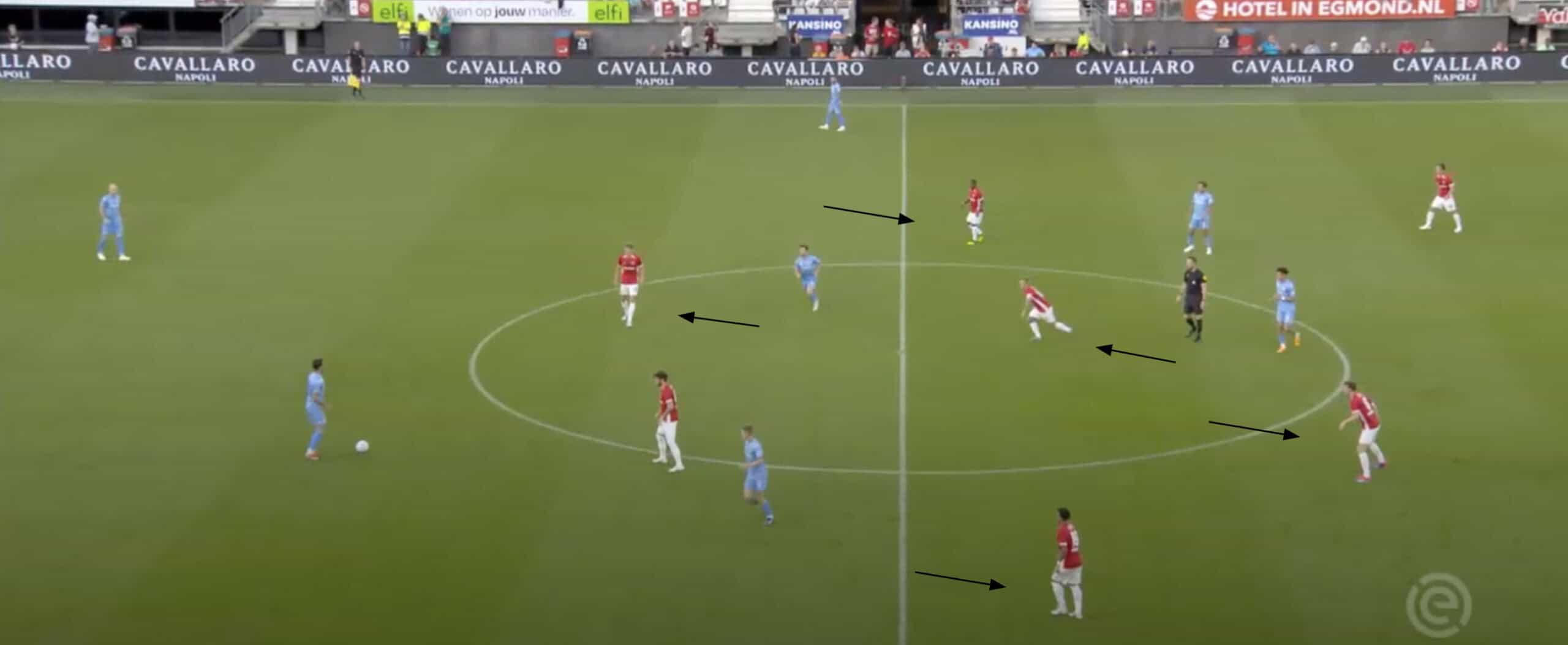
An emerging pattern that’s developed throughout the games this season is the way and the shape in which AZ like to press higher up the field to try and disrupt the opposition’s plays by defending from the front.
One example is above from the game against NEC Nijmegen, where we can see Mijnans pushing up alongside Parrott and the double pivot doing likewise from behind, creating a 4-4-2 shape.
Just as in possession, we can see the pivots taking turns between who sits deeper and who pushes up, in this case, to join the front players for a higher press.
In this example, it was Clasie who pushed up with Koopmeiners dropping deeper in case the ball goes in behind the front players.
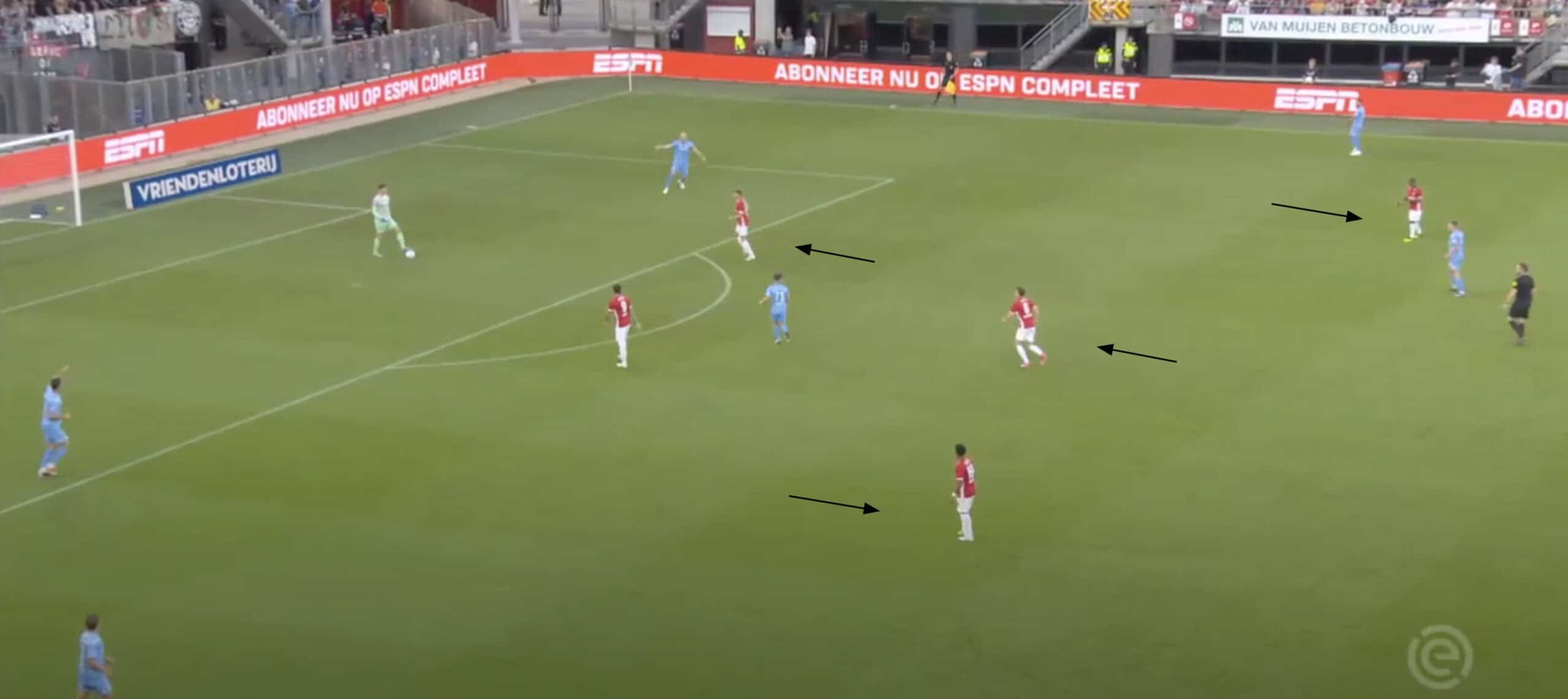
Another example of their pressing method is illustrated above, with Koopmeiners, this time being the one pushing up, while Clasie (not pictured) is the one sitting deeper.
AZ Alkmaar High Regains Map
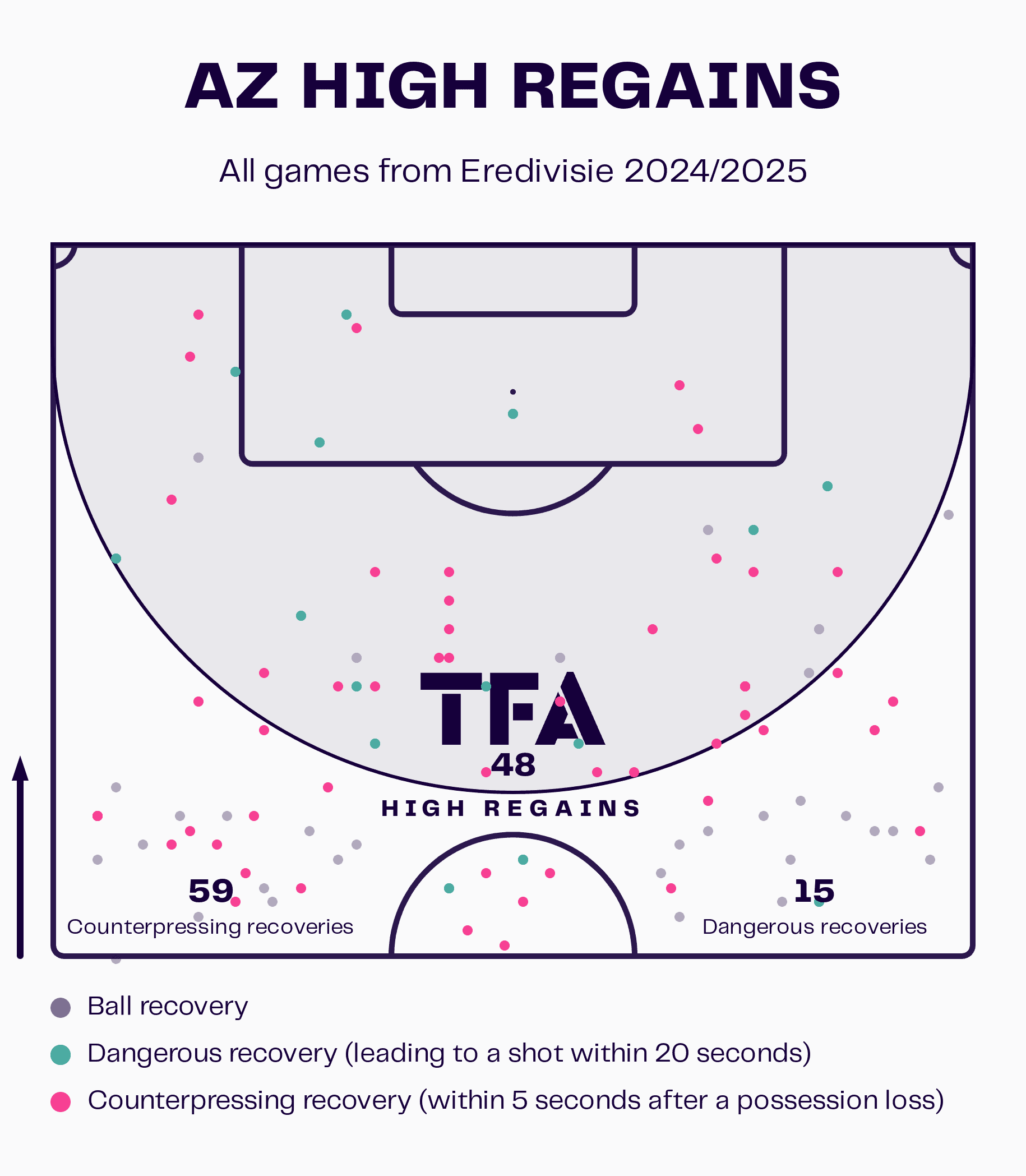
As the data visualisation above shows, AZ have already had great success this season with their pressing strategy, averaging about 15 counterpressing recoveries and 12 high regains per game.
This has all contributed to their defensive success.
By hassling the opposition into making mistakes and regaining possession, they’ve been able to control games well defensively and face a limited amount of danger on their own goal.
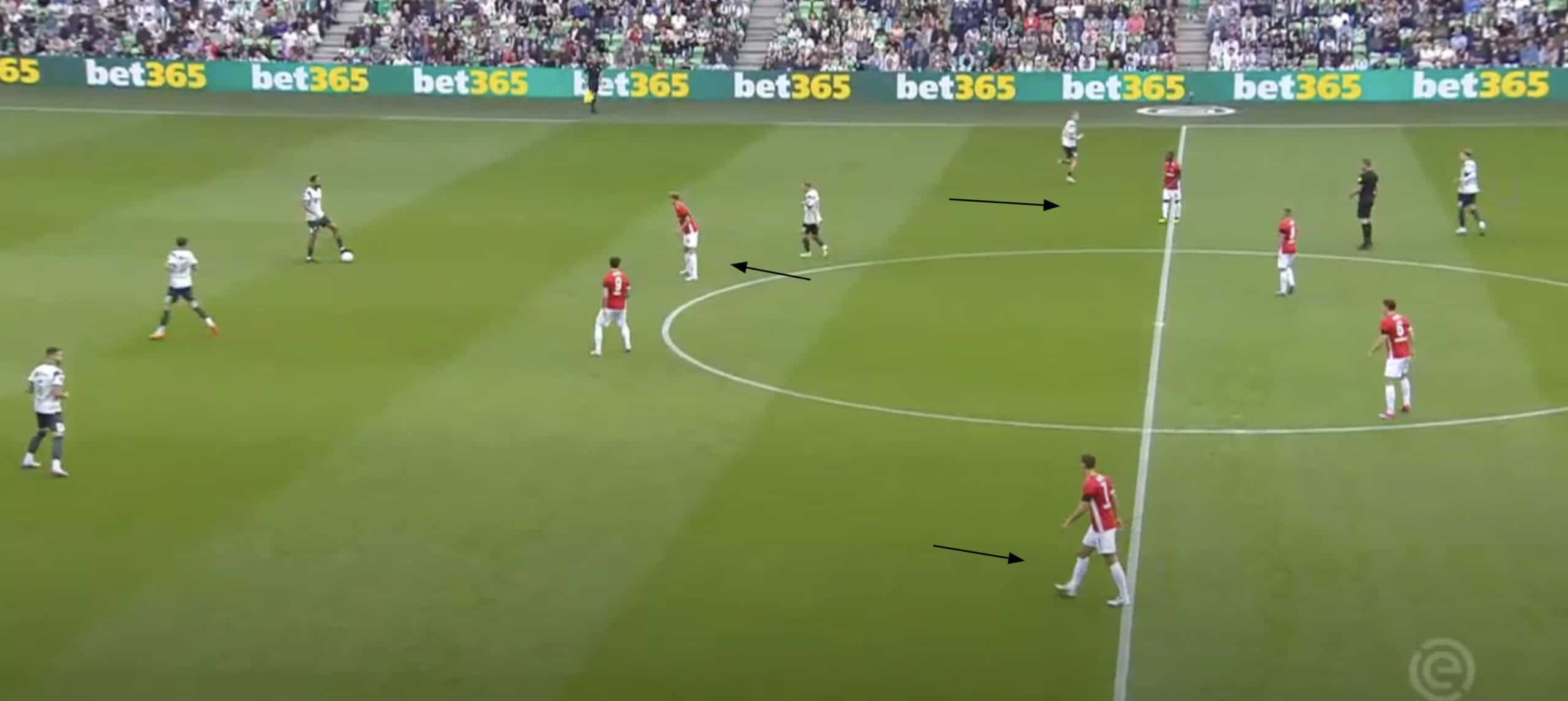
Another key note to mention about their pressing and how they defend in general is their wide players’ role in that regard.
As we can see in all of the examples above regarding their pressing, both wingers take up a narrower position, allowing them to have a more compact shape and making it difficult for the opposition to access the central areas on the pitch.
This forces them to either go wide or backwards, which then results in the winger nearest to the ball moving out wide to try to win the ball off them or support their full-back defensively.
Everything about the way they defend is carefully considered and done in unison, hence why it’s no surprise that four games into the season, they’ve yet to concede a single goal.
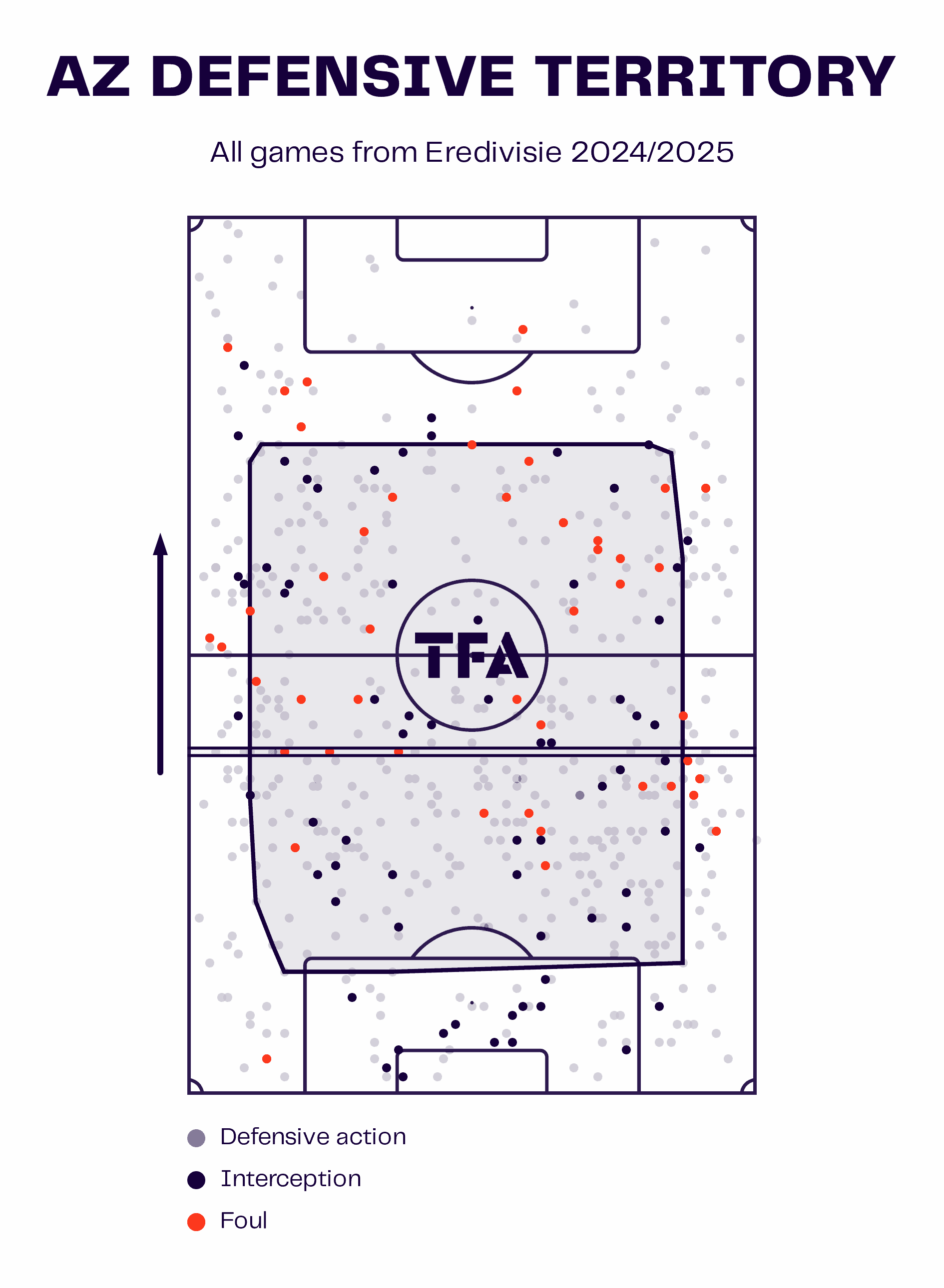
As the data visualisation above depicts, they’ve done well to establish themselves well in the defensive half of the field, particularly in the areas where the double pivot of Clasie and Koopmeiners occurs, where most of their interceptions and defensive actions take place.
AZ Alkmaar Transitions
One thing that was mentioned earlier is how AZ like to be more direct and quick in how they get the ball from back to front.
This is especially true in transitional phases when they can win the ball higher up the field.
As soon as they are able to do so, the ball winner immediately tends to look for an outlet, either to play in behind or a ball over the top for a runner to latch onto.
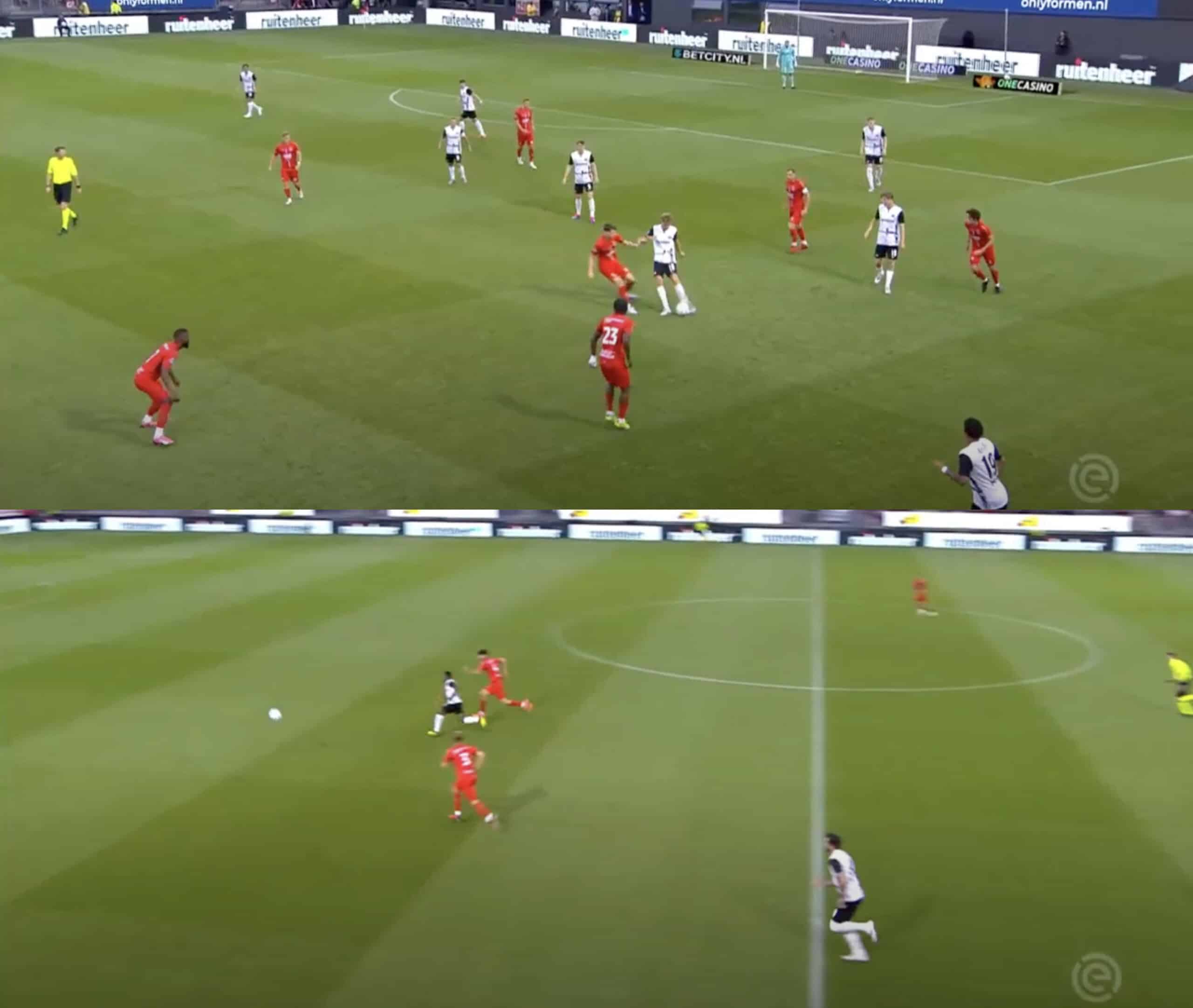
An example of that is the play above, which led to AZ’s first goal of the season away at Almere City.
Mijnans plays an early long ball over the top for Sadiq, who took up a more central position with Parrott dropping deep as he often does, and he finished clinically for the only goal of the game.
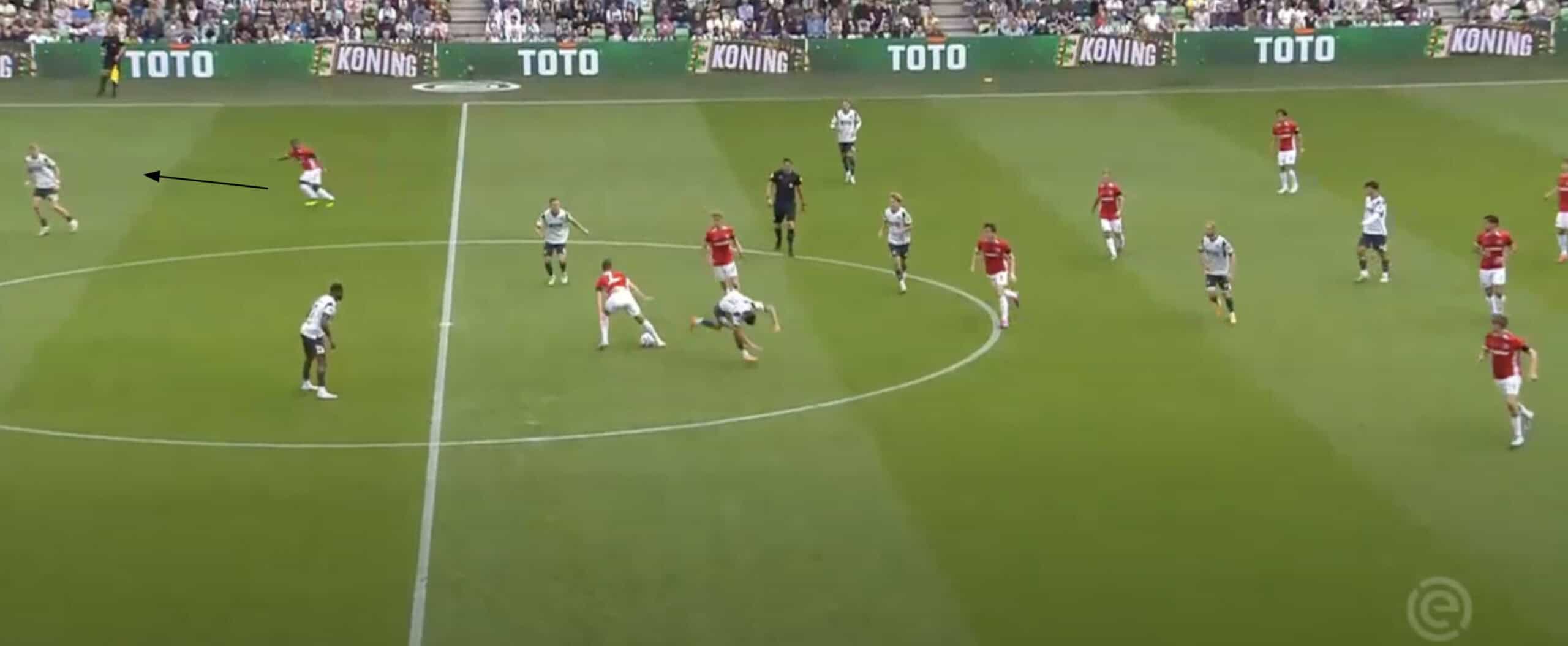
Similarly, here, van Bommel wins the ball off a Groningen midfielder.
Sadiq’s body language immediately moves to sprinting behind the defender and receiving the ball in space, which he does.
Always positive, always looking ahead to the next play and how they can get the ball in dangerous areas, that’s the AZ way under Martens.
It’s interesting to note that AZ played the most long balls on the opening day out of all 18 teams in the league, most of which were looking for runners in behind.
While some of this is due to the fact that they went down a man early, they kept this in their lockers in the games that followed, particularly as the opposition would push up higher in search of a goal themselves.
AZ Alkmaar Set Pieces
Lastly, we’ll look at their set-piece strategies, which, like every other aspect of their game, have a lot of variety in how they approach things.
There were a couple of particularly common methods they utilised in all four games when it came to attacking set plays, which we’ll unpack below.
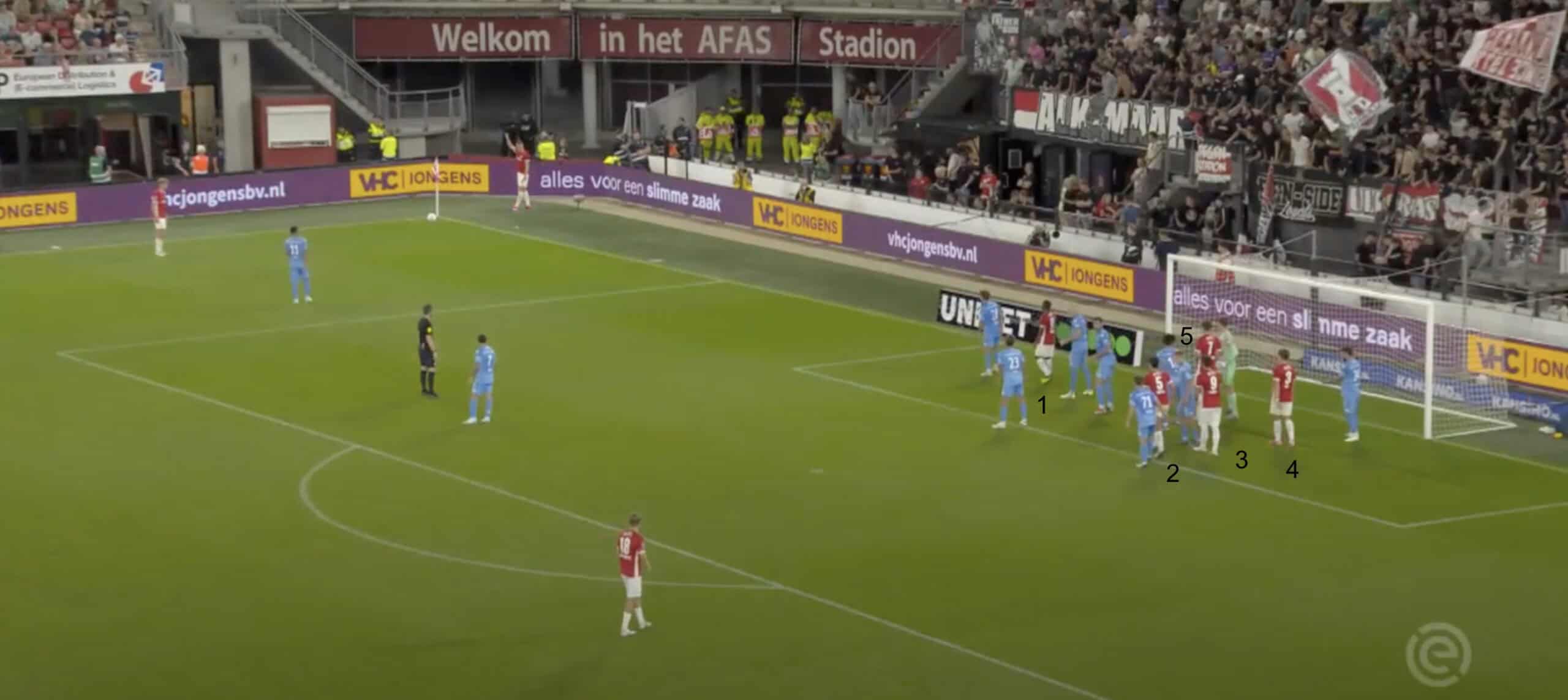
Firstly, we’ll look at this example against NEC Nijmegen.
Five players crowd the six-yard box, all positioned at or around the near post area.
These would be their starting positions.
As the ball came in, the player nearest to the taker (marked as ‘1’) would peel away, creating space for two or three players to attack.
The other(s) would move to the far post, where the ball would usually go when they deployed this strategy.
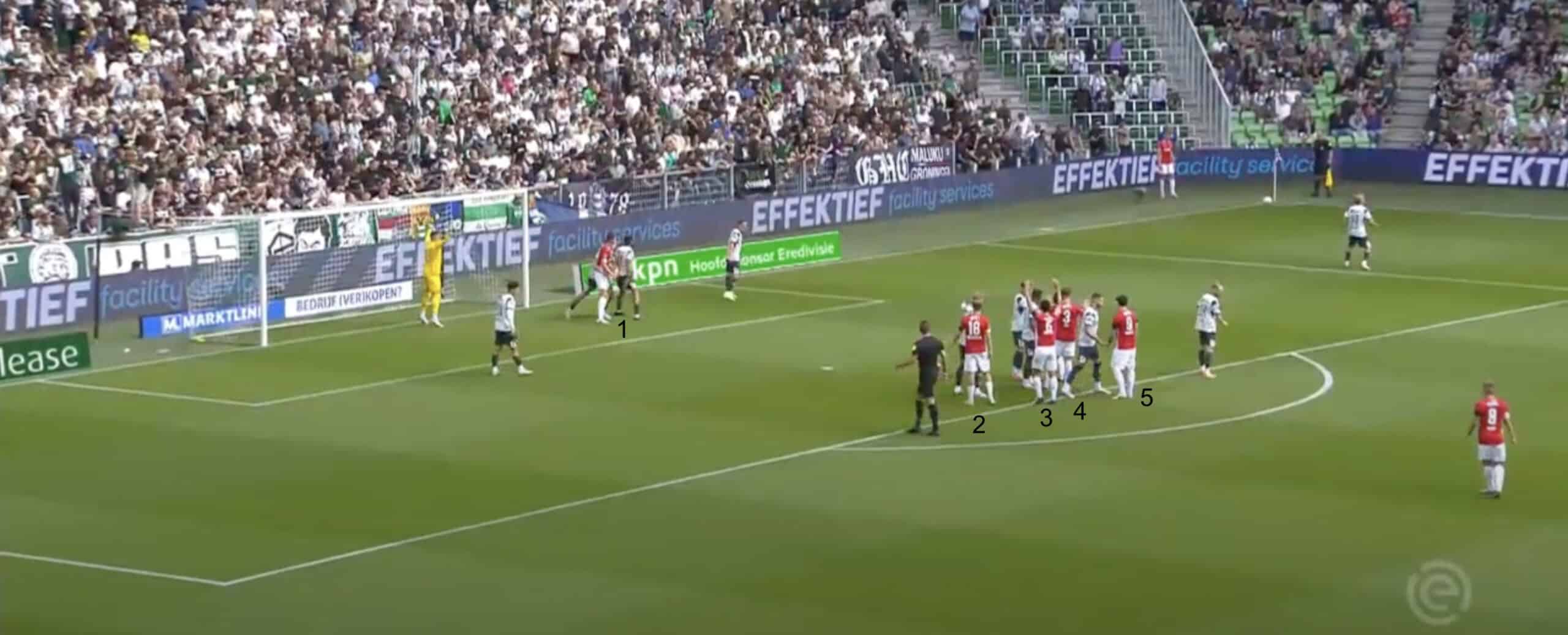
Another variation they’ve used is with just one player positioned at the near post and five or so starting their runs on the edge of the penalty area.
As the ball would come in, again the player at the post would peel away and drag out his marker, creating space for some of the AZ players to run into while others would go to the opposite post.
They haven’t scored yet from a set piece this season, but their approach has been interesting enough to note, and better service could lead to more positive results from them in the future.
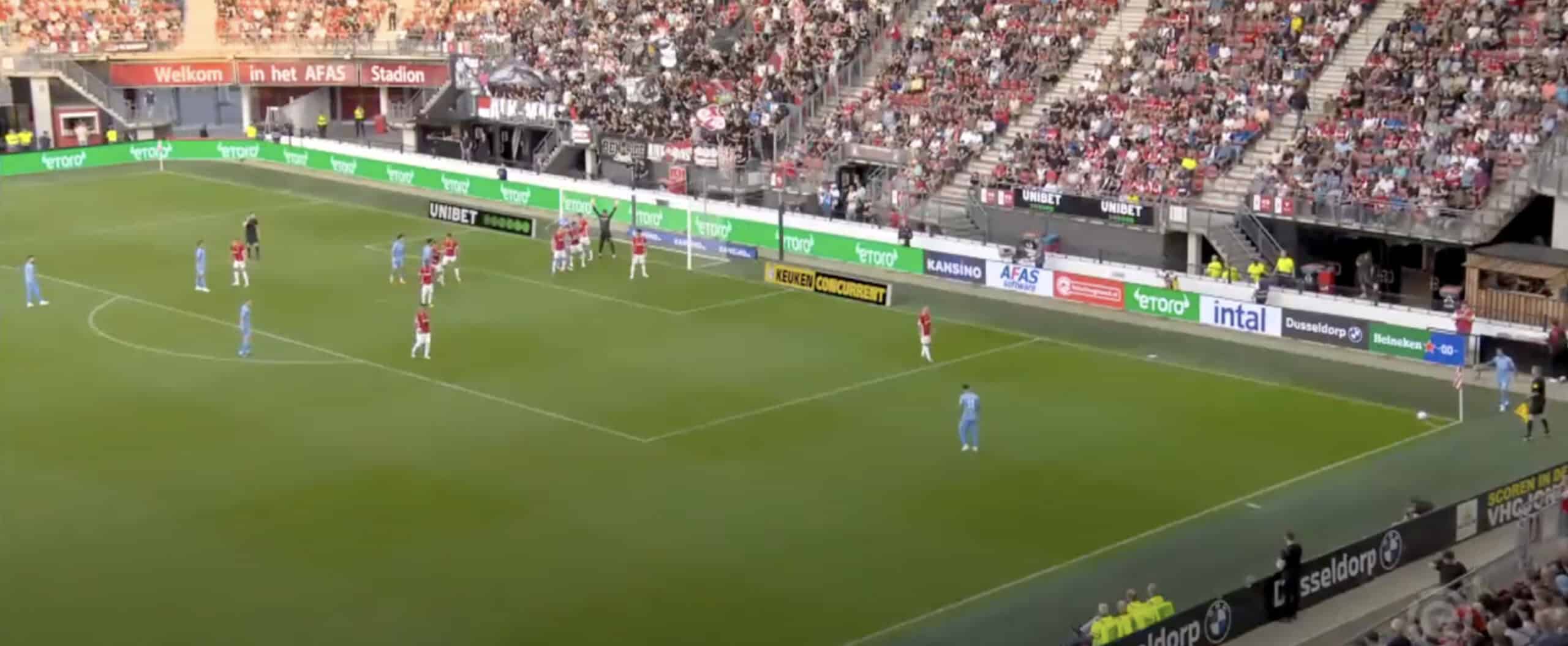
On the defensive side of set plays, it’s been mostly a mix of man and zonal marking, as is depicted above.
Three or four players crowd the six-yard box in front of the goalkeeper while the others are in and around the penalty spot, each with their own specific covering duties.
Their mixed approach has, as of yet, worked to good effect as they rarely even concede a shot on goal from a set play.
Conclusion
So, as we’ve seen throughout this analysis, Martens has developed an interesting unit in Alkmaar with the players buying into his methods and a continuation of the work under Pascal Jensen, under whom Martens was an assistant.
A tight defence accompanied by an exciting offence with inventive ideas has been AZ’s solid start to the campaign, and it will be fascinating to see how far they can go this year under the Belgian manager.
Balancing three competitions will be a challenge, but if they can keep up the form they’ve shown this early on, perhaps we could see AZ Alkmaar battling to win a major trophy, which would be their first in twelve years.
Martens was a player on the side that won the last trophy in the KNVB Beker; maybe now, as a manager, he can steer them to their next glory.

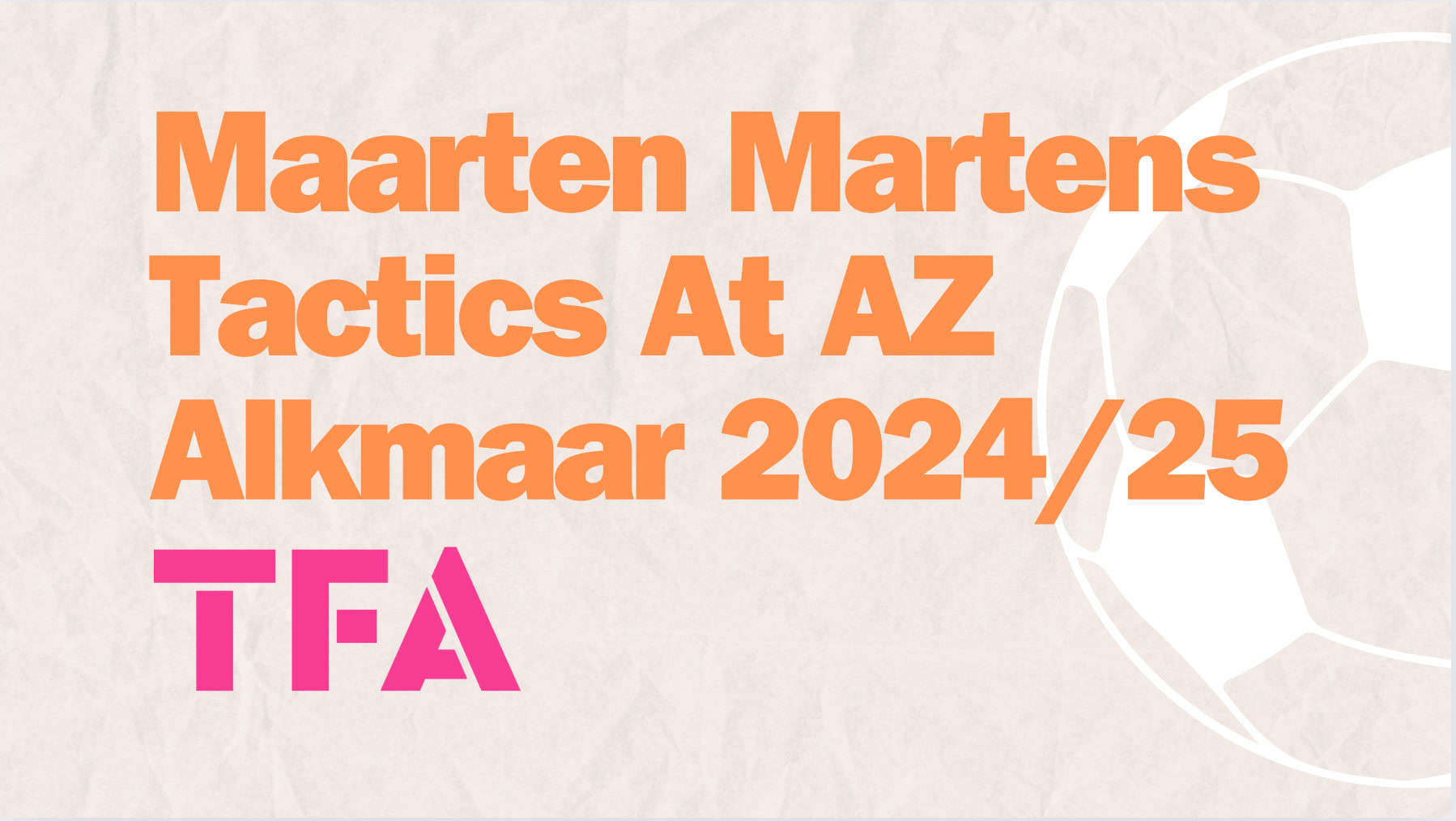




Comments